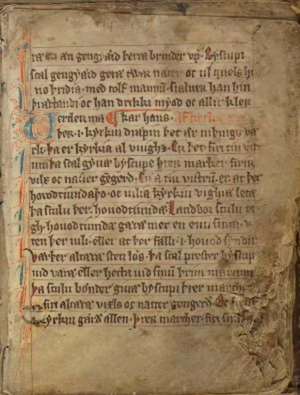Skrzypek, Dominika, Alicja Piotrowska & Rafał Jaworski. 2021. The diachrony of definiteness in North Germanic. Brill’s Studies in Historical Linguistics 14. Leiden: Brill. ISBN: 978-90-04-43603-9. https://brill.com/display/title/58312
Scandinavian languages, just like English, make use of articles which denote the categories of definiteness and indefiniteness. In other words, articles tell us whether the topic of conversation is known and specified for the speakers, or whether the conversation is about something new or unspecified. In many languages articles occur before nouns just like in English (the girl, a girl). In Scandinavian languages the indefinite article behaves similarly to the English one (in Swedish: en flicka ‘a girl’), but the definite article occurs after the noun in a form of a suffix (in Swedish: flicka-n ‘the girl’).
In the early history of Scandinavian languages articles did not occur, just like in present-day Polish. The articles developed in the process known as grammaticalization. The process consists in a gradual development and change of a lexical word (for example, pronouns such as this and that) into a grammatical element that must appear by the noun. In Scandinavian languages, this process took place between the 13th and 16th centuries.
The book written by Prof. Dominika Skrzypek, Alicja Piotrowska PhD and Rafał Jaworski PhD presents the results of the analysis of article development in the history of Danish, Swedish and Icelandic. Mediaeval texts were the main subject of the research, among them the laws of various provinces, which are the oldest texts written in Scandinavia using Latin alphabet. The authors conducted a detailed analysis of contexts in which articles appear first and most frequently by combining qualitative methods typical for historical linguistics with some of the most recent statistical methods. Thanks to the statistical modelling the Authors uncovered the factors that significantly influenced the development of the articles in different contexts. Among these factors, pragmatic aspects come to the fore – the articles occurred most often with nouns denoting the most important persons or objects in the given context, to which the speaker wanted to draw particular attention. The research presented in the book confirms empirically and statistically earlier intuitions of researchers within the field of Scandinavian linguistics.
